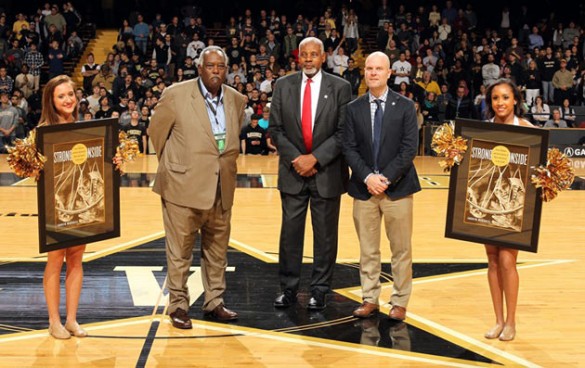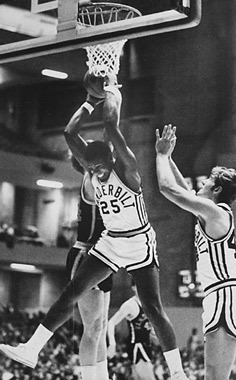
Vice Chancellor for Athletics and University Affairs and Athletics Director David Williams helped recognize Vanderbilt basketball great Perry Wallace (center) and author Andrew Maraniss (second from right) during halftime of the Dec. 4 men’s basketball game. (Steve Green/Vanderbilt)
By Andrew Maraniss
He wasn’t going to trade one plantation for another.
That’s how Perry Wallace describes the realization he came to in 1966, when as a Nashville high school senior he concluded that the Big Ten universities he had set his sights on may not have his best interests at heart.
As co-captain of his undefeated, state champion Pearl High School basketball team and valedictorian of his class, Wallace was one of the most highly recruited players in the country. When he realized his basketball talents could earn him a scholarship, Wallace saw the sport as a means to an end – a way out of Nashville, out of the South, out of segregation.
But on his recruiting trips to the Big Ten powerhouses, he saw something he didn’t like: many of the athletes, especially the African American ones, he believed, were merely being exploited for their athletic abilities. They were steered to easy classes, provided very few social outlets, shuttled from their dorm to the basketball court and back, day after day. It was not the future Wallace had envisioned for himself, and it opened the door to a most unlikely alternative: Vanderbilt University.
When Coach Roy Skinner began recruiting Wallace, the star pupil listened. He was impressed by Skinner’s demeanor – genuine and low-key – and impressed most of all by something else: the Vanderbilt engineering school.
As a kid, Wallace had always been the kind to tinker around with electronics, and he had enjoyed his math and science classes in high school. He described himself as a “Sputnik-effected” kid, influenced by teachers and events that propelled bright young students into math and science, nearly out of a sense of civic responsibility or patriotic duty.
So when he toured campus and learned of the engineering school’s outstanding reputation, and saw that the Commodore student-athletes were encouraged to go to class and excel as students, he began to take Vanderbilt seriously, eventually signing his scholarship papers with Skinner at a press conference at Memorial Gym. (See Wallace visits Nashville for book launch Dec. 4, 2014)

Of course, Wallace was no ordinary engineering student or basketball player.
In signing with Vanderbilt, he made history, becoming the first African American basketball player in Southeastern Conference history, an assignment that required tremendous courage.
Looking back on his Vanderbilt days from the distance of nearly a half-century, Wallace, now a professor of law at American University in Washington, D.C., said one of the things he’s most proud of is his engineering degree. He majored in electrical engineering and engineering math.
“It has been of great benefit in several crucial ways,” he says. “First and foremost is the power of the training in rigorous analysis, which has had applicability in a range of endeavors including law, business, government and the military. Next would be the development of a penchant for detail and precision, two other qualities that have enhanced my personal and professional lives.
“Additionally, in my work involving environmental and energy law, my training has given me a ‘competitive advantage’ over the other lawyers, as these fields require a mastery of science and technology. Similarly, my work in corporate law and finance, as well as in international arbitration, has often involved businesses involved in high technology and infrastructure development. In all these areas, it was always a pleasant surprise to the other, non-legal professionals to encounter a lawyer – and a minority one at that – who could truly ‘speak their language.’”
While Wallace said he encountered some students and others who did not believe that he – or other black students – could succeed in the engineering school, he said his prevailing memories are of his many supporters.
He has fond memories of numerous professors, recalling “one of the true bright spots” of his Vanderbilt years being the way they “embraced and nurtured (his) intellectual development. Former Dean Ken Galloway reached out to me years ago and we have kept in touch all the while,” he recalled.
“People like Eugene Stephenson, George Cook, Larry Wilson, Francis Wells, Wayne Sullivan, Frank Norris, Frank Parker, ‘Papa Joe’ Hendrickson, Ensign Johnson, Paul King, Bill Rowan and others still stand out in my mind. Importantly, this was not simply ‘hero worship’ for a popular jock. The bottom line was that the work had to be done, and done well.”
Doing the work. It’s what attracted Wallace to Vanderbilt in the first place. And what he recalls most fondly about his days on West End.
Andrew Maraniss (B.A. ’92) is the author of a new biography on Perry Wallace titled Strong Inside: Perry Wallace and the Collision of Race and Sports in the South. For more information on the book, visit www.andrewmaraniss.com. Follow Maraniss on Twitter @trublu24.